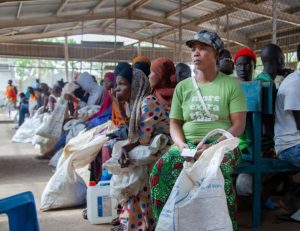World’s largest refugee camps face food crisis
 Millions of people in the world’s largest refugee camps are facing a hunger crisis as aid agencies struggle to provide enough nutrition and food.
Millions of people in the world’s largest refugee camps are facing a hunger crisis as aid agencies struggle to provide enough nutrition and food.
And the situation could yet worsen as grain supplies from Ukraine are again blocked by Russian aggression.
The UN’s World Food Program (WFP) says 6.6 million people living in the world’s largest camps face hunger as well as limited access to medical care – a situation exacerbated by language barriers and unemployment.
The four worst affected camps are the Kutupalong camp in Bangladesh, home to 880,000 refugees; the Kakuma and Dadaab camps in Kenya, each housing 200,000; and the Za’atari camp in Jordan, home to 80,000 refugees.
The Kutupalong camp at Cox’s Bazar in Bangladesh is home to Rohingya refugees, most of whom fled from neighbouring Myanmar in 2017 due to ethnic and religious persecution.
The Rohingya, who have been in Myanmar for centuries, have faced decades of discrimination and repression. They are one of the largest stateless populations in the world. Six years ago, hundreds of thousands of Rohingya streamed into Bangladesh to escape violence in Myanmar. Rohingya families continue to flee Myanmar.
Because of a fund shortage, the WFP recently cut monthly food rations for the Rohingya refugees from $US10 per person to $US8 – amounting to less than nine cents per meal.
The cut follows a previous one in March, when, citing a $US56 million funding black hole, the agency reduced the monthly food aid from $US12 to $US10 per person.
The sprawling Kakuma camp in the desert region of north-west Kenya is home to about 200,000 refugees, many of whom have lived there for more than 25 years after fleeing conflict and climate extremes in their home countries, which include South Sudan, Sudan, Somalia, the Democratic Republic of the Congo, Burundi, Ethiopia and Uganda.
Kakuma residents face relentless dust storms, high temperatures and malaria outbreaks.
Under Kenyan law, they are required to remain in the camp and children entering the camp often stay into adulthood.
This also means refugees at Kakuma are not able to work to support themselves and agriculture is not possible due to the climate.
The WFP provides food and cash assistance to people experiencing severe hunger in camps as well as school meals for children. But funding shortfalls have recently seen these supplies reduced.
The Dadaab camp complex in eastern Kenya was initially created in 1991 to provide temporary shelter to people fleeing violence in Somalia and is managed today by UNHCR.
A recent influx of new refugees from Somalia to Dadaab is putting strain on a camp already at capacity. Funding is not keeping pace with these rising needs and Dadaab residents are currently receiving 80 per cent of the usual rations from the WFP.
The Za’atari Refugee Camp in Jordan opened in July 2012 and today houses 80,000 people. It houses refugees from the protracted refugee crisis in neighbouring Syria.
Just four per cent of refugees in Za’atari have work permits, and women are often excluded from employment opportunities because of cultural norms.
Most Syrian families in Jordan rely on humanitarian aid to meet their daily needs and hunger is a rising issue with more than 80 per cent of Syrian refugees in in Jordan either already hungry or on the brink of hunger.
The WFP says the food security situation in Jordan is increasingly precarious. Between 2020 and 2021, the number of refugees experiencing hunger in the country doubled.
Read more here: Hunger in the 4 Largest Refugee Camps in the World – World Food Program USA (wfpusa.org)












